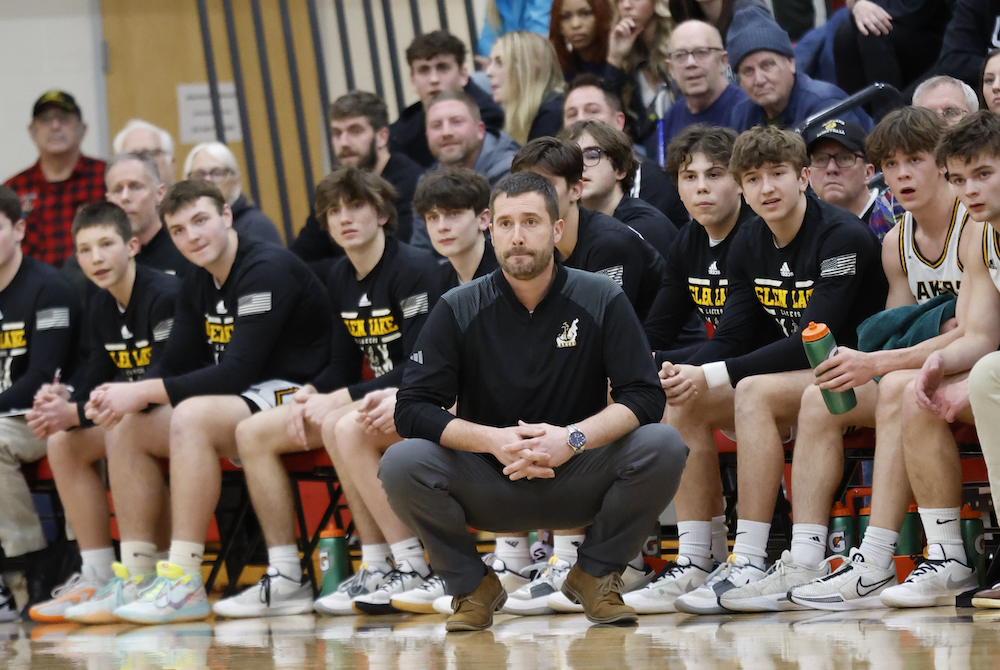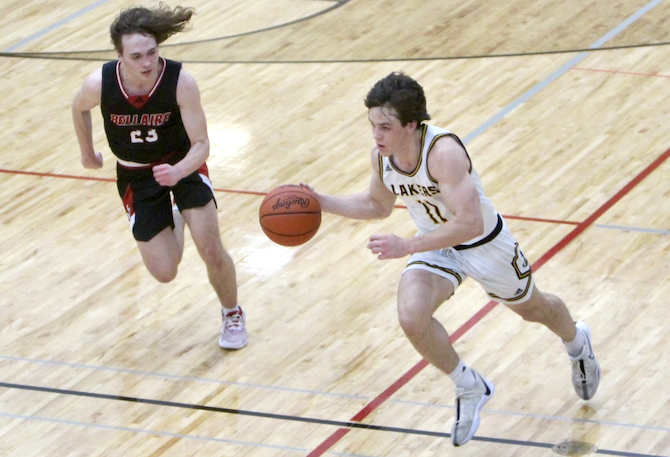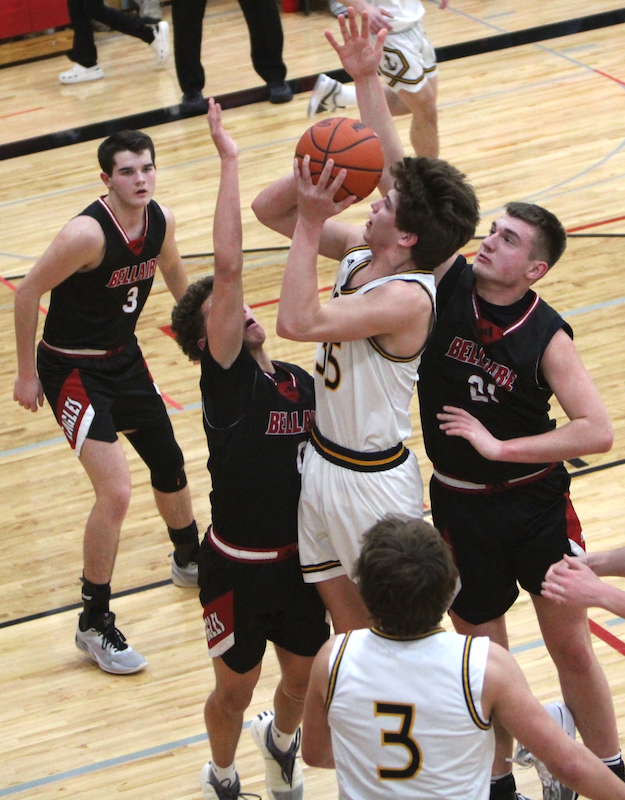
Staying Ahead on Head Safety
July 6, 2015
By Rob Kaminski
MHSAA benchmarks editor
Three stacks of concussion-related material offered precious little space on MHSAA Executive Director Jack Roberts’ desk, and perhaps consumed even more room in his head as he tried to wrap his mind around the seemingly daily “latest and greatest” documents outlining signs, detection and return-to-play elements involving head trauma.
Without a doubt, the scene is quite similar on any given day in the offices of his cohorts across the country as school sports leaders are faced with the daunting, dizzying task of devising plans to address concerns aimed at the health of their games.
Lawmakers, rules makers, medical experts and the court of public opinion all want the same thing for student-athletes: a reduction in the chances of head-related injuries. And they all are perfectly willing to offer instant fixes to those in charge.
They often expect those in Roberts’ position to analyze, digest and create action plans as soon as possible without considering the research and resources it will take to get there.
“All parties involved want the same thing. We all want to provide the safest environment for educational athletics through protocols and practices that will offer the most minimal risk of injury,” Roberts said. “But, this can’t be accomplished through unfunded mandates which would stifle the already struggling athletic budgets in many schools.
“Changes have to occur through training and education, orchestrated through state offices and executed locally. And, it takes time to research the best and most effective means. There is so much information, and so many devices in the field today that those in athletic leadership roles almost have to have a medical background as well.”
For instance, there are documents which list as few as five symptoms for concussions, and those listing as many as 15. There are sideline detection methods which purport to take 20 minutes and those which claim to determine concussions in 20 seconds. There are as many return-to-play protocols as there are state associations.
Increasingly, state high school associations are seeking opinions and expertise from local medical personnel. In March, in one of many such meetings, Roberts and other MHSAA staff welcomed several from the Michigan Department of Health and Human Services to their office to discuss sideline detection methods and return-to-play issues.
“There are two areas that concerned us most,” Roberts said. “One, sideline detection of head injuries is inconsistent across the state in terms of both results and resources. Two, we need methods which generate immediate reports and permanent records.”
As the group which convened in March discussed the topic, potential hurdles and new perspectives on sideline management came to the forefront.
On the money and manpower front, who would be responsible for administering sideline tools? Most ideally they would need to be overseen by medical personnel rather than coaches or team managers.
From a perspective standpoint, an interesting view was volleyed out to the group: could sideline detection actually speed up a student’s return to play rather than slow it down? Current protocol prescribes that if competition continues while an athlete is withheld for an apparent concussion, that athlete may not be returned to competition that day but is subject to the return-to-play protocol. And, clearance may not be on the same date on which the athlete was removed from play. Only an M.D., D.O., Physician’s Assistant or Nurse Practitioner may clear the individual to return to activity. With immediate sideline detection, are parties more vulnerable should a student pass immediate tests, only to have undetected effects of the incident increase over time?
“The group shed a different light on the various scenarios, which was a primary purpose for the meeting,” Roberts said. “As one can see, there are so many variables to consider when attempting to determine the next plausible and practical steps toward minimizing and detecting head injuries.
“Further, we have to take into consideration practice sessions as well as competitions, and all sports, not just select sports.”
Adding to the challenge is simply the nature of athletics. Competitors at any level are just that: competitive. Often, students – or their parents – will attempt to hide symptoms or be reluctant to come forward with injuries, particularly head injuries which can’t be seen.
In more cases, perhaps the symptoms simply are not recognized, which is why education is paramount.
First, association leaders have to tackle the due diligence of researching issues and potential solutions to situations currently threatening the well-being of scholastic sports. Considering that some 1,620,000 results are offered when “sideline concussion detection tools” is typed into a search engine, this is a laborious and continual chore.
Such information then needs to be packaged and presented to leaders at the local levels – athletic directors – to pass on to coaches, the individuals who have as much or more influence on students that perhaps any other adults, including parents in some cases.
This is why MHSAA rules meetings, Coaches Advancement Program sessions and other statewide forums continue to bang the drum on health and safety issues; to make sure the messages and procedures reach the student-athletes.
And, it’s why the MHSAA is asking coaches and ADs to be accountable in verifying that the plans in place are being carried out.
Less Could Mean Less
There are times when it’s good to say, “less means more,” but in the case of contact sports, practices and competitions, the idea is for less to mean less. As in less time for collisions to occur yielding fewer injures.
It’s early yet, and one year does not constitute a large sample size, but the MHSAA Football Practice Policy instituted last August could be one step toward reducing head injuries.
Beginning this past football season, the number of practices with helmets, shoulder pads and full pads were limited to start the season, and preseason “collision” sessions were limited to one per day. During the season, such practices were limited to two per week, while the length of practices was also regulated.
Dr. Steven Broglio of the University of Michigan Neurosport department is conducting a three-year study of the Ann Arbor Gabriel Richard football program with the assistance of Richelle Williams to determine the “Effects of Concussion and Sub-Concussion.” The study began in 2013, one year prior to the new MHSAA guidelines.
Research in 2013 showed approximately 650 “impacts” per player. In 2014, the number dropped to approximately 500 impacts per player. Impacts are defined as greater than 10 gs of acceleration. Williams stated that a slap on the back is 4 g, coughing is 3.5 g. On average, a helmet hit is 25-45 g. Concussions usually happen (roughly) between 80-150g.
An encoder is embedded into each football athlete’s helmet which monitors head impacts and exactly where the impact is located. Williams sits at each practice and game and through a pager identifies the player’s number and impact from a hit of 90g or more.
They are also looking at those who do not sustain an impact concussion, but rather sustain multiple head impacts and whether those multiple head impacts lead up to brain changes (measured through EEG).
The initial findings, as submitted by the study team, indicated two reasons why there were fewer overall impacts from 2013 to 2014:
Primary reason: The MHSAA adoption that became effective in August 2014 with new limitations that were placed on “collision practices” and conditions that full pads could not be worn until the fifth day of team practice.
Secondary reason: Fewer players evaluated in 2014 than 2013.
Fit for a King?
Editor’s Note: There are many sideline detection tools on the market, as a quick Google on the topic will reveal. The following, the King-Devick test, is among the highly recommended tests, summarized here simply to provide an idea of the types of systems available and how they operate. The following is from King-Devick’s website.
The King-Devick Test is an objective remove-from-play sideline concussion screening test that can be administered by parents and coaches in minutes. The King-Devick Test is an accurate and reliable method for identifying athletes with head trauma and has particular relevance to: Football, Hockey, Soccer, Basketball, Lacrosse, Rugby, Baseball, Softball and Other Collision Activities.
King-Devick Test is an easy-to-administer test which is given on the sidelines of sporting events to aid in the detection of concussions in athletes. King-Devick Test (K-D Test) can help to objectively determine whether players should be removed from games. As a result, King-Devick Test can help prevent the serious consequences of repetitive concussions resulting from an athlete returning to play after a head injury.
How King-Devick Test Works
Concussions are a complex type of brain injury that is not visible on routine scans of the brain, yet are detectable when important aspects of brain function are measured. King-Devick Test (K-D Test) is a two-minute test that requires an athlete to read single digit numbers displayed on cards or on an iPad. After suspected head trauma, the athlete is given the test and if the time needed to complete the test is any longer than the athlete’s baseline test time, the athlete should be removed from play and should be evaluated by a licensed professional.
Remove-From-Play vs. Return-To-Play
Both remove-from-play and return-to-play decisions are crucial in concussion recovery. It is critical to remove a concussed athlete from play in order to prevent further damage. It is also extremely important to keep the athlete from returning to play until they have made a full recovery. There are tools to assist in making both remove-from-play and return-to-play decisions.
King-Devick Test for Remove-From-Play Decisions
- Quick, objective sideline testing
- Measures impairments of speech, language and other correlates of suboptimal brain function
- Instant screening feedback in minutes
- Administered by parents, coaches, athletic trainers and medical professionals in remove-from-play decisions
- Neurocognitive Testing for Return-To-Play Decisions
- Computerized concussion evaluation system (in the computer lab)
- Measures verbal and visual memory, processing speed and reaction
- Tracks recovery of cognitive processes following concussion
- Assists clinicians in making return-to-play decisions

After Leading Glen Lake Girls to Title, Bradford Brings Boys Into Final Week
By
Tom Spencer
Special for MHSAA.com
March 15, 2024
Eight is Enough.
 Or is it?
Or is it?
For Jason Bradford growing up on the farm of Arden and Lynn Bradford as one of their eight children, it probably was enough. Bradford’s upbringing may have been slightly similar to “Eight Is Enough,” a comedy-drama television series about a family with eight children that aired on ABC from March of 1977 to May of 1981.
But the show didn’t depict pick-up basketball being played in the barn like it was for Bradford and his siblings. And surely eight would not be enough Regional basketball championships for Jason Bradford, nor enough District titles either.
After leading Maple City Glen Lake to the Division 4 girls basketball championship last year, Bradford stepped down from coaching. At the time his teams had won five Regional and six District titles.
Now his teams have won six Regional and seven District championships. He took over Glen Lake’s boys program during the holiday break this winter as the Lakers were off to a 4-2 start. They finished the season 22-5.
It was the Lakers boys’ first 20-win campaign since the 2018-19 season, and they clinched their first Regional title since 2018.
Glen Lake went 19-5 last year losing to Traverse City St. Francis in the District Final. The season before that ended with a first-round loss to Elk Rapids and 15-6 record.
Bradford led his girls teams four times to the MHSAA Semifinals and almost got their a fifth time this year with the boys. Their run ended Tuesday with a tough loss in the Division 4 Quarterfinals to Mount Pleasant Sacred Heart, 63-51.
“We’re licking the wounds of that one,” he said. “We’ve got to remember to look at the big picture – they are young men becoming men.”
 But Bradford already has turned his thoughts to next season and is making plans for summer basketball.
But Bradford already has turned his thoughts to next season and is making plans for summer basketball.
“Having the summer with them if it goes the way we want is going to be huge,” Bradford said. “There are a few things going through my head I can change or adjust.
“We want to continue to build on what our philosophy of what Glen Lake is and my philosophy of what Glen Lake is.”
The Lakers will graduate Cooper Bufalini, Gage Baker, Dylan Cundiff, Tyler Bixby and Jamie Blondia. But they’ll have their top two scorers back, sophomore Jacob Plamondon and junior Benji Allen. Plamondon kicked in almost 20 points per game and led the team in rebounding with more than 10 per contest. Allen averaged more than 11 points per game and led the team in assists.
Glen Lake finished second in the Northwest Conference behind Benzie Central, which was undefeated in league play. The Lakers knocked off league opponents Frankfort in the Division 4 District title match and Buckley in the Regional Semifinal.
The battles with Benzie for the conference title may have been the highlights of the season, Bradford noted. Those were Glen Lake’s only losses in league play, and a share of the title was within their grasp late in the second game with the Huskies.
The Lakers lost 60-51 on their home court in the first meeting but took Benzie to the limit in the rematch before falling, 41-39, on the road.
“We had a lot of great games and a lot of great memories,” Bradford said. “Going for conference it pretty much came down to the last few seconds with lead changes.
“We were up by one point with less than 30 second lefts, and that was the high point,” he continued. “We came up short, but we learned from that game.”
Also among highlights for Bradford this year was the chance to coach against his brother Nathan for the first time in their careers.
 The Bradfords started coaching girls varsity basketball 16 years ago, but their teams were in different conferences at the time. Nathan coached the Onekama girls but moved to the boys program before Onekama and Glen Lake had a chance to compete against each other in the Northwest Conference.
The Bradfords started coaching girls varsity basketball 16 years ago, but their teams were in different conferences at the time. Nathan coached the Onekama girls but moved to the boys program before Onekama and Glen Lake had a chance to compete against each other in the Northwest Conference.
The Bradford coaches often talk after their games and learn from one another. They have also seen their parents frequently in the bleachers as they rotate home game sites to see their grandchildren play and their sons coach.
When Onekama and Glen Lake played this year, eight Bradfords were on the rosters as players or coaches. Jason’s son Toby, a freshman, played on the Glen Lake junior varsity team, as Nathan’s son Carson played for the Portagers’ JV squad. The Onekama JV team is coached by another Bradford, Jason and Nathan’s brother Nick. And there were three more Bradfords on the varsity – Nathan’s son Caden and his cousins Luke and Arden.
Glen Lake won both varsity games, 38-36 at Onekama and 61-33 at home.
Jason and his wife Jackie have five children. Their youngest son, Drew, is now a sixth grader at Glen Lake. His oldest son, J.J., is at Michigan Tech and has begun officiating basketball after his senior season at Glen Lake cut short by the pandemic while the Lakers were preparing to play in a 2020 District Final. Daughters Maddie and Grace are playing basketball for Lake Superior State University.
Maddie and Grace were big parts of Glen Lake’s deep postseason runs with Jason as girls coach. With many games played on Saturdays and not conflicting with coaching, Jason, Jackie and the younger boys were able to travel to see the Upper Peninsula’s Lakers play regularly.
This season, the Glen Lake girls – under first-year head coach Brad Fosmore – went 16-8 and won Northwest Conference and District titles before losing a nail-biter, 45-42, to league rival Frankfort in the Regional Semifinal.
“Jason did a good job, and it felt good to carry on the tradition,” said Fosmore, who previously served as a Lakers JV coach. “We took it one game at a time.
“Jason worked hard to build a great girls program,” he continued. “It made it pretty simple because they had that winning tradition and kind of kept it rolling.”
 Tom Spencer is a longtime MHSAA-registered basketball and soccer official, and former softball and baseball official, and he also has coached in the northern Lower Peninsula area. He previously has written for the Saginaw News, Bay County Sports Page and Midland Daily News. He can be reached at [email protected] with story ideas for Manistee, Wexford, Missaukee, Roscommon, Ogemaw, Iosco, Alcona, Oscoda, Crawford, Kalkaska, Grand Traverse, Benzie, Leelanau, Antrim, Otsego, Montmorency, Alpena, Presque Isle, Cheboygan, Charlevoix and Emmet counties.
Tom Spencer is a longtime MHSAA-registered basketball and soccer official, and former softball and baseball official, and he also has coached in the northern Lower Peninsula area. He previously has written for the Saginaw News, Bay County Sports Page and Midland Daily News. He can be reached at [email protected] with story ideas for Manistee, Wexford, Missaukee, Roscommon, Ogemaw, Iosco, Alcona, Oscoda, Crawford, Kalkaska, Grand Traverse, Benzie, Leelanau, Antrim, Otsego, Montmorency, Alpena, Presque Isle, Cheboygan, Charlevoix and Emmet counties.
PHOTOS (Top) Jason Bradford, kneeling, coaches the Maple City Glen Lake boys varsity after taking over the program earlier this season. (Middle) Glen Lake’s Cooper Bufalini (11) pushes the ball upcourt during a 65-49 District Final win over Bellaire. (Below) The Lakers’ Jacob Plamondon (35) makes a strong move to the basket. (Top photo by RD Sports Photo/Rob DeForge, additional photos by Nicole Bixby.)

